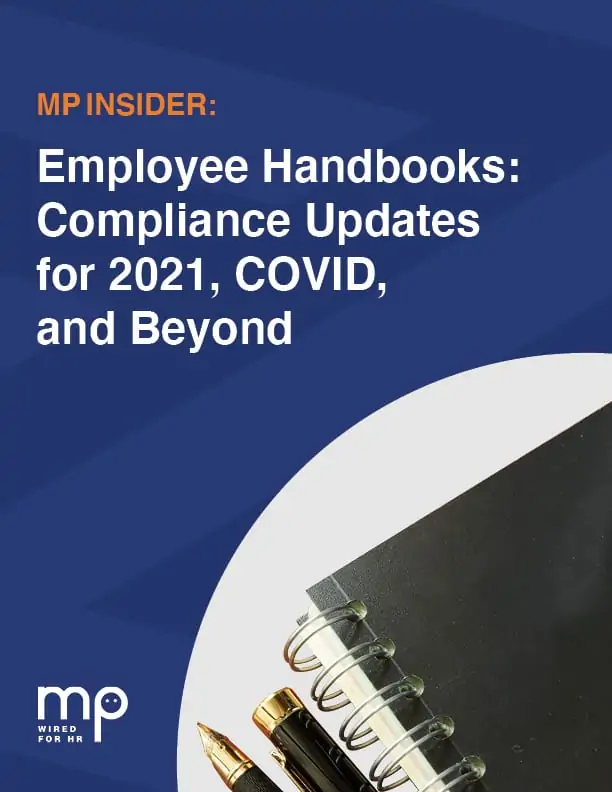Posted on October 21st, 2020
Employee Handbooks: Compliance Updates for 2021, COVID, and Beyond

MP INSIDER:
Employee Handbooks: Compliance Updates for 2021, COVID, and Beyond
Table of Contents
- How an Updated Handbook Protects Employers
- How Handbooks Improve Onboarding and Training
- Tips for Creating or Updating an Employee Handbook
- Best Practices After Updating Employee Handbook
Introduction
Some companies haven’t updated their employee handbooks in a while. Some are even unsure why it’s ever important to update a staff handbook. However, a comprehensive handbook that’s updated on a yearly basis is always an important tool for an employer– but especially right now during the pandemic. The best employee handbook has true ROI. It helps protect the company from costly compliance violation fees and lawsuits, improves onboarding and training processes, assists management in navigating tricky employment decisions, sets expectations and guides employees towards better performance. During the pandemic, an updated employee handbook can help workplaces move forward in a completely remote or hybrid telework plan. This eBook covers how to build an employee manual that serves your team and your business goals– especially through COVID.
How an Updated Handbook Protects the Company
It’s important to update employee handbooks about once a year because federal, state, and local laws change. Just in 2020, several states (including California and New York) modified their compliance requirements around sexual harassment. This affected numerous workplaces directly. In the Supreme court, protected classes were expanded to include gender identity and sexual orientation at the federal level. These are important items that a thorough employee manual would include. If a business is based in multiple states, their handbook needs to be compliant with all applicable laws for these locations.
COVID Changes in 2020
Among the latest updates surrounding COVID, there’s another interesting layer to this multi-state problem: if employees will now be permanently working primarily or completely remotely, their home states and cities matter more than ever. In some cases, if staff originally commuted to a workplace in a different state, the company could now be subject to laws that pertain to their employees’ home states, cities, etc. Employers should seek advice from an HR consulting group like MP if they have questions about this topic.
Internal Company Changes
Beyond external changes like new laws, companies change internally, too. If a company grows or shrinks (as many have during the pandemic) different laws and regulations now apply to them. When a company expands over 50 employees, for example, they may eventually need to comply with certain laws, like the FMLA and the ACA.
Protection Against Fines and Lawsuits
An employee handbook should be updated frequently. Being proactive is key, especially when it comes to matters of compliance. If a company gets ahead of new legal requirements, it significantly mitigates risks of costly fines, lawsuits, and just the general cost of a reputation as a bad employer. It’s also worth noting that if an employee manual is full of outdated information and policies, it’s not likely to stand up in a legal battle—even if the subject matter in question has been updated. If the rest of the handbook is not accurate and enforced, lawyers will argue that none of it can be enforceable.
“Maintaining an updated handbook is essential to minimizing risk and cultivating the employee experience. A great handbook should educate employees on the mission, vision and values that are engrained in the fibers of your organization as well as set expectations and engage employees.“
Amanda Leonardi, SHRM-CP

How an Employee Handbook Improves Onboarding and Training
Onboarding
The best employee onboarding is done uniformly. There should be no questions and no differences in information or policies. An employee manual is a tool that can help ensure that the onboarding process is optimized and standardized. It can also help ensure that expectations are set clearly for new hires or for employees that are promoted or moved to new roles. When a staff handbook clearly lays out expectations and can be referred to easily, workers have a better chance of performing to the level that managers expect. They are more likely to do what the company or organization requires of its staff to meet its larger business goals.
A clear and updated employee handbook can support a great workplace culture where teamwork, high productivity, creativity, and proactive employees are rewarded. (Additionally, in a worst-case scenario, a handbook can help if workers don’t meet standards. It can help to facilitate employee feedback, disciplinary actions, or even termination. To help ensure the manual’s efficacy, employees should be required to read and sign it after receiving it. Ideally, this would be on or before their first day with the company (and generally after every update).

Remote Onboarding for the Pandemic and Beyond
Improving the onboarding process is especially important now, during the pandemic, as many companies hire and onboard their employees in a remote environment. Having an updated, digitized employee handbook that’s accessible anytime, anywhere, will make onboarding easier for new hires who may never set foot in the office. Whereas employees typically learned corporate culture and rules in the office by watching others, things have changed. Employees who will be working entirely remotely may need to learn the company culture and policies by reading and referring to their handbooks (in addition to working closely with their new managers).

Telework Policy
During this time, employers operating remotely should consider updating their staff handbook with a telework policy. Particularly if a company doesn’t have an existing telework policy, the pandemic may have changed a company’s operations dramatically. Suddenly, there are no standards for communication, collaboration, how work is shared or submitted, and how responsive staff needs to be. A telework policy can also address time and attendance procedures, which are very important when it comes to non-exempt staff. Since any employer is responsible for paying a non-exempt staffer for all time worked, a solid telework policy will be deeply necessary. There must be agreement on how many hours employees will work, how they will clock in and out, and how they will request and get approval for overtime. Without an updated remote work policy, employers might be on the hook later for unpaid time (or, more expensive, unpaid overtime)!
Tips for Creating or Updating an Employee Handbook
Whether a workplace already has an employee manual, or it simply hasn’t been updated for years, below is a checklist of important considerations. If the handbook is missing items on this list, an HR department may want to create and/or include them in their handbook. Some of these items listed below may have become more significant since COVID, especially a remote work policy. For advice and guidance on creating an employee handbook tailored to your business, reach out to MP’s HR services team.
2021 Employee Handbook Checklist
Does your staff handbook include these items?
Best Practices After Updating Employee Handbooks
Updating the employee handbook yearly is a critical practice for companies because it can save them time and money. It can also help them maintain a clean reputation and improve their work environment. It’s important to note, though, that what companies do afterwards can be just as impactful. Below are best practices for distribution, acknowledgement, and management.
Distributing an Employee Handbook
Once an employer has created or updated their staff handbook, how they share it can be just as important. While many businesses had physically printed their handbook, the ideal way to share this document now is electronically. When distributed digitally, it is easy to update whenever there’s a new law or policy. It’s also simple for workers to refer back whenever they have a question, or for a manager to highlight for an employee if they’re having a performance issue. MP clients can upload their handbooks to iSolved, so all employees have access and are able to acknowledge electronically.
Acknowledgements
One of the best HR strategies is not just to share the employee handbook, but to have new hires sign (or digitally sign) once they have received and read it. This procedure ensures that all parties have comprehensive guidance, that managers are applying policies consistently with their direct reports, and that everyone is responsible for following all rules and policies. Additionally, this may come in handy should a manager need to give feedback (or perhaps some legal backup if, in a worst-case scenario, an employee complains or sues).
Tips for Employee Handbook Distribution
- Share your employee handbook in a digital format: Email, on a shared drive, on an intranet, on Teams or Slack
- Share in team meetings
- Get signatures acknowledging receipt – both at the date of hire and when the handbook is updated yearly
- Manage to the policies
Managing to the Policies
Managing to the policies is a vital practice. Ignoring them in company operations, even some of the policies some of the time, can negate the effect of the entire handbook. When managers only apply policies sometimes, or only apply some of the policies, workers have a hard time trusting that any employee policies will be enforced and followed. Another facet of this topic is ensuring that managers and administration are also following policies from the manual themselves. When they only enforce these policies for their reports, but don’t follow policies themselves, managers create confusion, mistrust, and resentment. This can poison a corporate culture. Ideally, policies are applied and practiced as uniformly as possible throughout the company. Of course, acceptable caveats occur when a job’s duties make it impossible to apply a policy in exactly the same way. However, even in these cases, it’s important for managers to make a best effort to apply policies in the same spirit.
On the flip side, a thorough, well-updated handbook can help a company nurture the kind of culture that encourages comradery, cooperation, collaboration, and higher productivity. This is the kind of workplace that retains talent, avoids lawsuits and fines, and regularly meets its business goals—all in part because of a comprehensive employee handbook.
Even the best handbook won’t protect you unless you “manage” to the policies.
Sheri Heller, SHRM-CP, PHR, MEd
Trust MP to Help
MP has been a leading provider of HR and payroll solutions for companies across the US for nearly two decades. We offer a comprehensive suite of products and services delivered in one unified, easy-to-use platform. We support clients as they cultivate excellent corporate culture, improve employee engagement, and strive towards their business goals. Since 2014, MP has been on the Inc 5000 list and has won the Boston Business Journal Fastest Growing Companies Award.

